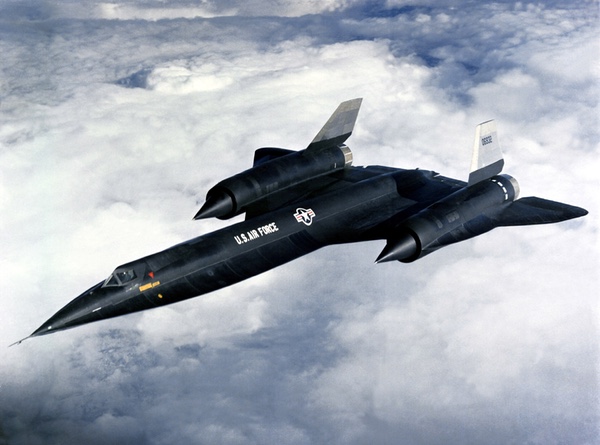Blackbirds and black satellites: the A-12 OXCART as a satellite launcherby Dwayne Day
|
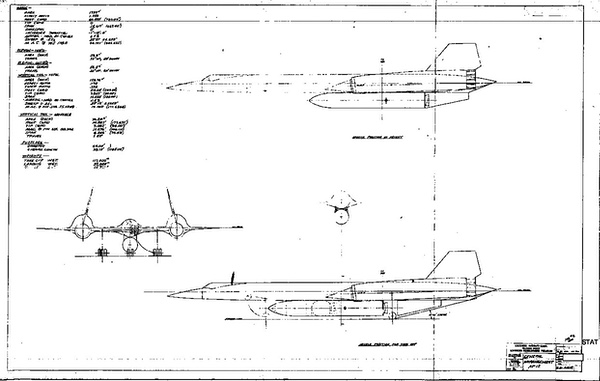 The 1962 Lockheed proposal was for a rocket carried by a modified A-12 reconnaissance plane. The recommended option was to carry the rocket underneath the aircraft, which presented problems for retracting the landing gear. (credit: CIA) |
That’s the case with Lockheed Missiles and Space Company’s 1962 proposal to use a Mach 3 A-12 OXCART spyplane to launch a reconnaissance satellite into space. The A-12 OXCART was the predecessor to the much more famous SR-71 Blackbird. Lockheed’s proposal wasn’t the craziest idea in aerospace, but it also did not make a lot of sense, which is undoubtedly why it was not pursued. But the basic concept of a quick reaction reconnaissance satellite, or piloted spacecraft, persisted for decades after this proposal.
| Lockheed’s proposal wasn’t the craziest idea in aerospace, but it also did not make a lot of sense, which is undoubtedly why it was not pursued. |
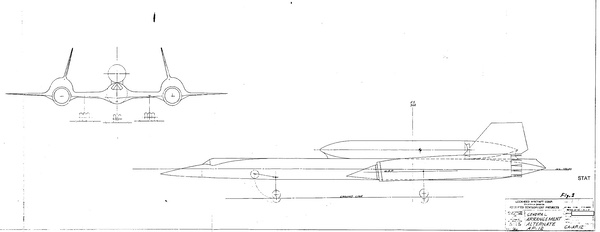 The alternative configuration would have put the rocket on top of the aircraft and it would have slid backwards for deployment. This would have dramatically altered the center of gravity for the carrying aircraft in flight and been very dangerous. (credit: CIA) |
The aircraft would take off from Hawaii and cruise to 250 to 600 miles (400 to 965 kilometers) east. The aircraft would launch the rocket at an altitude of 80,000 feet (24,400 meters) while traveling at Mach 3. It would be launched in a southeastern trajectory and the rocket would carry the satellite into an 80-nautical-mile (148-kilometer) orbit that would pass directly over the target in the Soviet Union. It would not technically enter orbit but instead would reenter the atmosphere; the reentry vehicle would descend near Johnston Island in the Pacific Ocean 87 minutes later. It would deploy a parachute and be caught in mid-air. Accuracy would be high enough to ensure that the spacecraft would pass within five miles (eight kilometers) of the target.
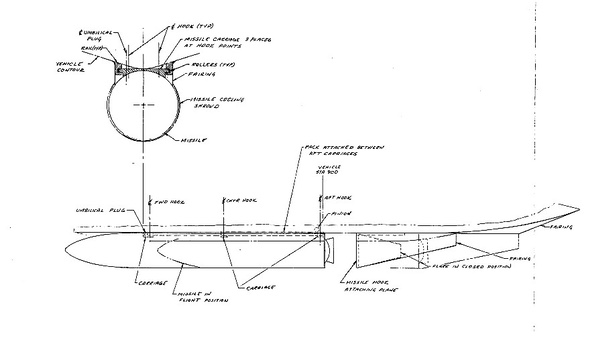 In order to avoid interfering with the landing gear, the rocket would have been mounted forward during takeoff, and then slid backwards after landing gear retraction. It would have connected with a rear fairing for flight. (credit: CIA) |
The safer method of deployment would be to carry the rocket underneath the aircraft. This presented a design challenge because the rocket would prevent the aircraft’s landing gear from folding up into the fuselage. The proposed solution was to mount the rocket forward, separate from an aft aerodynamic fairing. After the plane had taken off and the gear had been retracted, the rocket would slide back and connect with the fairing.
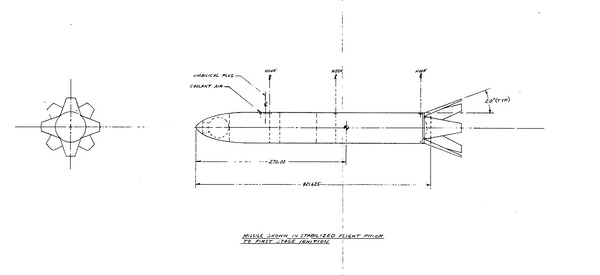 The rocket would have used a feathered rear fairing to stabilize it after deployment and during rocket ignition. (credit: CIA) |
The rocket and fairing would drop together and the fairing would then flare open like the petals of a flower to provide stability until the rocket ignited and the fairing was jettisoned. But the sliding rocket and its separate fairing were not the only unorthodox engineering proposals. The rocket required a new high-performance upper stage. But because of the length of the rocket, the upper stage would be mounted backwards. After separating from the first stage, the upper stage and payload would rotate 180 degrees to face forward before the solid motor ignited.
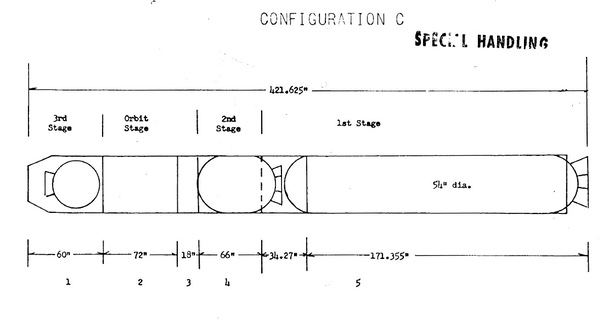 Another unusual feature of the rocket was that the third stage would have been mounted backwards and would have had to yaw 180 degrees before firing its motor. (credit: CIA) |
If the mission had to abort, the rocket would be jettisoned, because the aircraft could not land with the rocket attached, blocking its landing gear.
Lockheed proposed another option, placing the rocket on top of the AP-12 carrier aircraft. The rocket would deploy a parachute and slide all the way aft on rails. But this would dangerously shift the center of gravity of the aircraft, and it was not the preferred method.
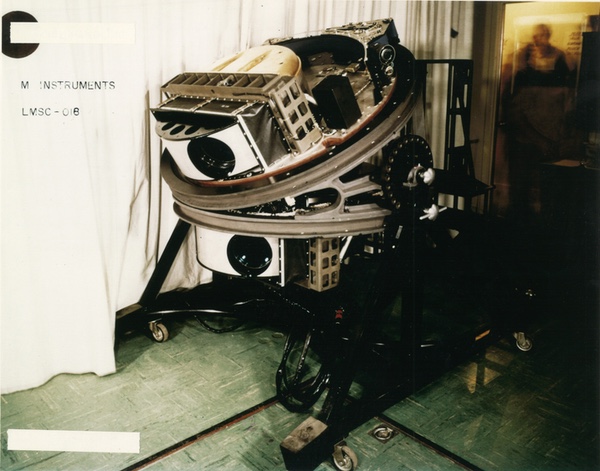 A CORONA-MURAL camera system for launch aboard a satellite. This system first entered service in 1962 but was eventually replaced within two years. The camera apertures are visible at center. The film moved along the curved surface at the top and was exposed in long strips. Lockheed’s 1962 proposal was to use a single MURAL camera in their rocket-boosted vehicle. (credit: NRO) |
The satellite would consist of a single CORONA-MURAL panoramic camera, which took pictures by swinging a camera lens back and forth. It would have 700 feet (215 meters) of 70 mm film. It could cover 92 nautical miles (170 kilometers) wide for a total of 180,000 square miles (466,000 square kilometers). Resolution was estimated at five feet (1.5 meters). The film would be taken up by a reel inside the reentry vehicle. The vehicle would separate from the rest of the craft in flight and fire a small solid rocket motor to bring it down.
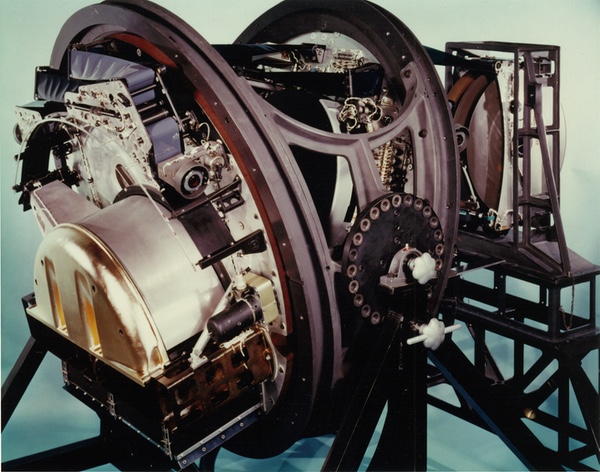 The CORONA-MURAL camera system prior to mounting inside its satellite vehicle. Some of the film is visible at top. The film from the two cameras was wound up on separate spools, visible at right. These spools were inside a reentry vehicle that detached from the spacecraft at the end of the mission and was recovered. The system was also known by the designation KH-4 CORONA. (credit: NRO) |
| What exactly Lockheed was trying to accomplish with its 1962 proposal is not exactly clear—beyond, perhaps, getting a CIA or Air Force contract to study the concept before giving up on it. |
The first CORONA-MURAL camera system had launched into orbit in February 1962. The CORONA-MURAL satellite was a dual-camera configuration, launched atop a Thor-Agena rocket from Vandenberg Air Force Base in California. MURAL stayed in orbit for several days and photographed far more territory than the Lockheed vehicle proposal that would not even complete a single orbit of the Earth.
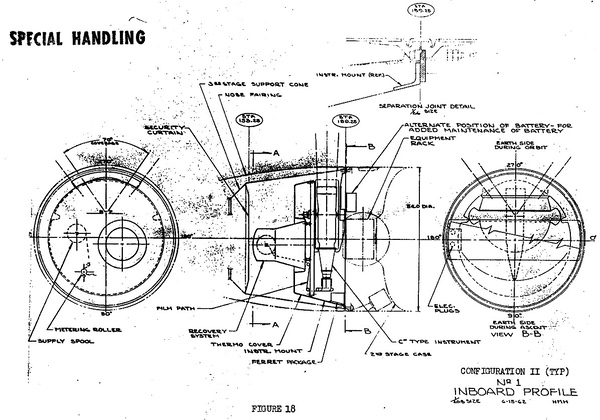 The payload section would have contained a single CORONA-MURAL camera sending its film to a small reentry vehicle. The cross section on the right shows how the camera would have looked up at the Earth. MURAL was a panoramic camera that swept back and forth (east-west), producing a long, thin image that covered a lot of territory. As the vehicle moved over the ground, the camera would keep sweeping back and forth, essentially "mowing the lawn" and covering substantial area both east and west and north to south. (credit: CIA) |
What exactly Lockheed was trying to accomplish with its 1962 proposal is not exactly clear—beyond, perhaps, getting a CIA or Air Force contract to study the concept before giving up on it. The CORONA-MURAL camera that they were proposing for their rocket was relatively low resolution. Assuming that weather conditions cooperated—the Soviet Union was often cloudy—the camera might be able to photograph an army on the move. But it would not have been very good at finding the kinds of targets that the Soviets might try to hide from observation. More pointedly, a high-speed launching aircraft was not really necessary to put the rocket into orbit. There were other options. Why launch a rocket and satellite and immediately throw them away when, for a bit more money, they could place the satellite in orbit for several days and photograph significantly more territory? Throughout the 1960s, the US intelligence community sought to maximize the intelligence return from its reconnaissance systems, seeking to extend the lifetimes of its satellites as much as possible. The CORONA-MURAL system that entered service in early 1962 was superseded in August 1963 by an improved system that doubled its film capacity and dramatically extended its lifetime.
The one potential value of such a high-speed, suborbital reconnaissance vehicle was that it provided “invulnerable reconnaissance.” Satellites entered predictable orbits, and the National Reconnaissance Office that operated them was concerned that the Soviet Union might try to shoot them down. A vehicle like the one Lockheed was proposing would have only shown up once on Soviet radars, too fast to shoot down before it crossed out of range.
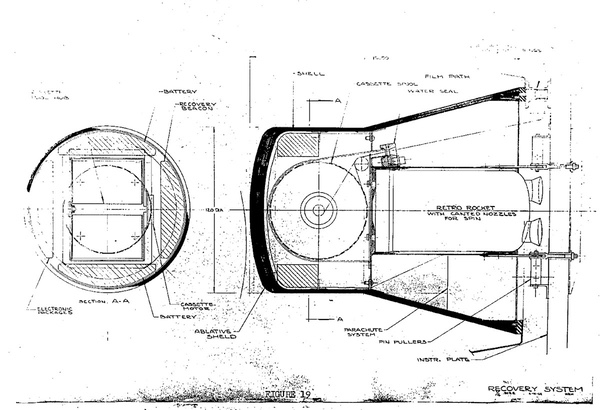 The reentry vehicle with its roll of exposed film. This vehicle would have deployed a parachute and then been captured in mid-air by a C-130 aircraft trailing a cable. After recovery, it would have been flown to a processing center and the film processed so it could be examined. (credit: CIA) |
Although Lockheed’s proposal was not adopted, the concept of a very high speed once around the Earth reconnaissance platform persisted and evolved into a more ambitious program known as ISINGLASS. (See “A bat outta Hell: the ISINGLASS Mach 22 follow-on to OXCART,” The Space Review, April 12, 2010.) It was also suggested for the X-20 Dyna-Soar program that was then underway but would be canceled at the end of 1963. Air launch of a crewed spacecraft capable of deploying a satellite, or operating a payload inside its payload bay, reemerged in the 1980s with the Air Launched Sortie Vehicle. In the early 2000s, Aviation Week & Space Technology ran a dubious cover story about the so-called “Blackstar” spaceplane launched off a supersonic B-70 bomber. (See “Higher burning: The Air Launched Sortie Vehicle of the 1980s,” The Space Review, April 19, 2021, and “Six blind men in a zoo: Aviation Week’s mythical Blackstar,” The Space Review, March 13, 2006.) A single pass, high-speed and high-altitude reconnaissance system was a solution in search of a requirement. The idea would persist for decades, but it was never implemented.
Note: we are using a new commenting system, which may require you to create a new account.
